When you walk into a pet store and see the huge variety of goldfish on display, you might be surprised to learn that they are all the same species.
Much like dogs, goldfish have been selectively bred for centuries, giving us the many different breeds we have now, with different shapes, colors, and sizes.
This guide will walk you through the different types of Goldfish you can own in your aquarium and some key information on how to care for them.
Table of Contents
Understanding the Different Types
Goldfish were first bred in China several hundred years ago. They were bred from the Prussian carp (also known as wild goldfish), which is a dull silver color, and they were first reared for food. But, as vibrant color mutations began to be seen, they were soon selectively bred for ornamental purposes.
As goldfish grew in popularity, more and more traits were selected as desirable by different people and were bred into the fish. Over time, this caused them to be diversified into the different varieties that we have today.
Single-tailed goldfish varieties are the closest to their ancestor in appearance. As a result, there are fewer different varieties as single-tailed ones have been left mostly untouched by selective breeding. They mostly vary by their color and tail shape alone.
Double-tailed goldfish varieties are much more diverse. Sometimes known as “fancy goldfish,” they have been specially bred to have all sorts of unusual traits. They usually have shorter, stockier bodies and move slower than single-tailed varieties. The two can’t be kept together, as a result, as they will compete for food.
Some of the larger, faster swimming varieties of goldfish need a lot of space and are better suited for life in a pond. Goldfish make great pond additions and large goldfish ponds are still a common feature in many Asian countries where the fish was first bred.
Nevertheless, all varieties belong to the same species, Carassius auratus, and they are now exported all over the world as the most popular aquarium fish.
Types of Single-Tailed Goldfish
It’ll come as no surprise that these fish have a single tail. Their body shape has also remained relatively unchanged for hundreds of years and they share the slender, elongated body of their ancestor.
1. Common Goldfish
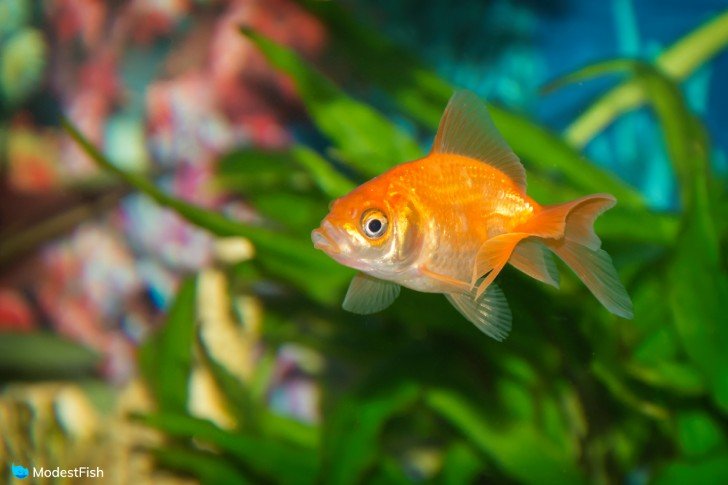
- Care Level: Easy.
- Temperament: Peaceful and social.
- Size: 10 inches.
- Min Tank Size: 40 gallons.
- Diet: Flakes, pellets, and live or frozen foods. Occasionally feeding some greens is also recommended.
As their name suggests, these are the most common goldfish variety; the standard, if you will. Everyone has probably owned, or at the very least seen, one at some point.
They have the classic body shape, and have a short tail and fins. There are a few different color varieties, including red, orange, yellow, white, and any combination of these.
While they generally reach a maximum of 10 inches in length, the world record is 19 inches. On top of that, they are active swimmers and, as a result, they do best in a pond of 100 gallons or more. This also satisfies their preference for colder water.
2. Comet Goldfish
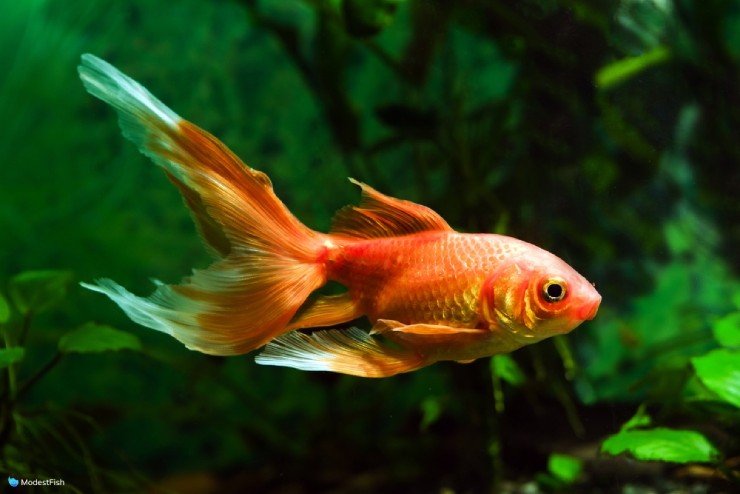
- Care Level: Easy.
- Temperament: Peaceful and social.
- Size: 12 inches.
- Min Tank Size: 50 gallons.
- Diet: Flakes, pellets, and live or frozen foods. Occasionally feeding some greens is also recommended.
Comets have a similar body shape to common goldfish, but have a long, flowing tail and fins. They are quite popular as their beautiful tails really make them stand out.
There are a number of color varieties, including red, yellow, orange, and white. There is also the sarasa comet, which is especially popular and is white with vibrant red patches.
Like common goldfish, comets can grow quite large and they are also a fast swimming variety. As a result, they need a lot of space and make great pond fish.
3. Shubunkin
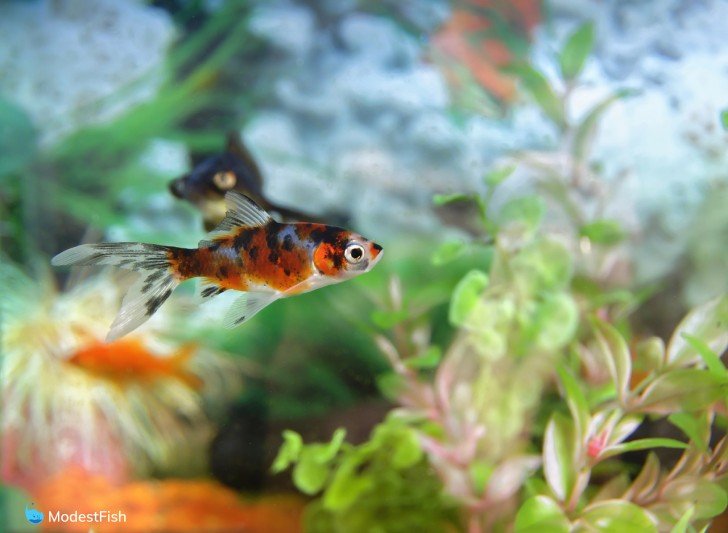
- Care Level: Easy.
- Temperament: Peaceful and social.
- Size: 12 inches.
- Min Tank Size: 75 gallons.
- Diet: Flakes, pellets, and live or frozen foods. Occasionally feeding some greens is also recommended.
There are three varieties of shubunkin. The American shubunkin is similar to a comet in shape but has the shubunkin’s iconic calico color. The London shubunkin is more like a common goldfish in terms of tail shape. Finally, the Bristol shubunkin is the most difficult to find and has a heart-shaped tail.
The colors present in the fish’s calico pattern include any combination of orange, blue, white, and black. Shubunkins also have a mixture of matte and metallic scales.
They make excellent pond fish and are especially winter hardy as they are not sensitive to cold temperatures. As with other single-tailed varieties, they need a lot of swimming space.
Types of Double-Tailed Goldfish
Double-tailed goldfish varieties have gone through a lot more selective breeding over the years. One feature common to all of them, though, is the double tail. Aside from that, they can vary greatly in body shape, tail shape, and the features that they have.
1. Fantail
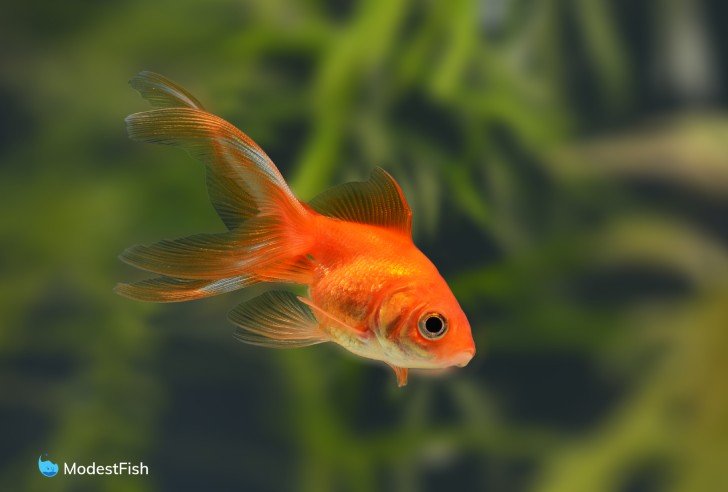
- Care Level: Easy.
- Temperament: Peaceful and social.
- Size: 8 inches.
- Min Tank Size: 20 gallons.
- Diet: Flakes and pellets with occasional greens. Some live or frozen food, though protein intake should be limited.
Fantail goldfish are the most common of the double-tail varieties. They have a distinct egg-shaped body, with an elongated dorsal fin and a long, flowing tail. There are also several color varieties, including orange, yellow, black, and even calico.
They are very hardy compared to other fancy goldfish, which often need specialised care. They are also agile compared to their fellow double-tails, but are still too slow to compete with single-tail varieties.
2. Oranda
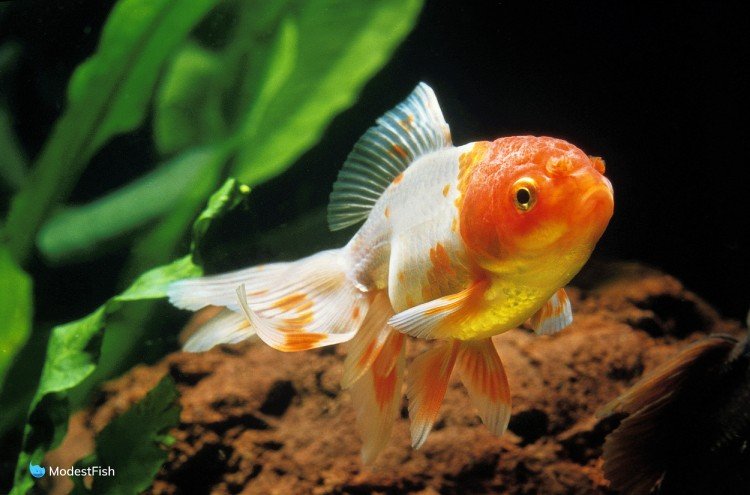
- Care Level: Easy.
- Temperament: Peaceful and social.
- Size: 7 inches.
- Min Tank Size: 30 gallons.
- Diet: Flakes or pellets with occasional live or frozen foods.
The oranda’s most notable feature is the fleshy mass on its head, known as a wen. The wen gradually becomes more prominent as the fish matures. Oranads come in a variety of colors, though the most iconic is probably the white oranda with a bright red wen.
They are one of the hardier and faster double-tail goldfish available, but still shouldn’t be housed with single tails. The aquarium setup needs to be carefully thought out as sharp corners or edges can damage the wen and lead to infection.
3. Wakin
- Care Level: Easy.
- Temperament: Peaceful and social.
- Size: 10 inches.
- Min Tank Size: 40 gallons.
- Diet: Flakes and pellets, as well as some live or frozen foods and plenty of greens.
Wakin goldfish almost look like a combination of a common goldfish and a double tail. They have a slender, elongated body like single-tailed varieties, but they have a short double tail. They are most likely the ancestor of many of the double-tailed varieties available today.
They grow larger and stockier than other double-tailed varieties, and they are more active swimmers. As a result, they need more space. Wakin goldfish are best kept in ponds, much like common goldfish.
4. Bubble Eye
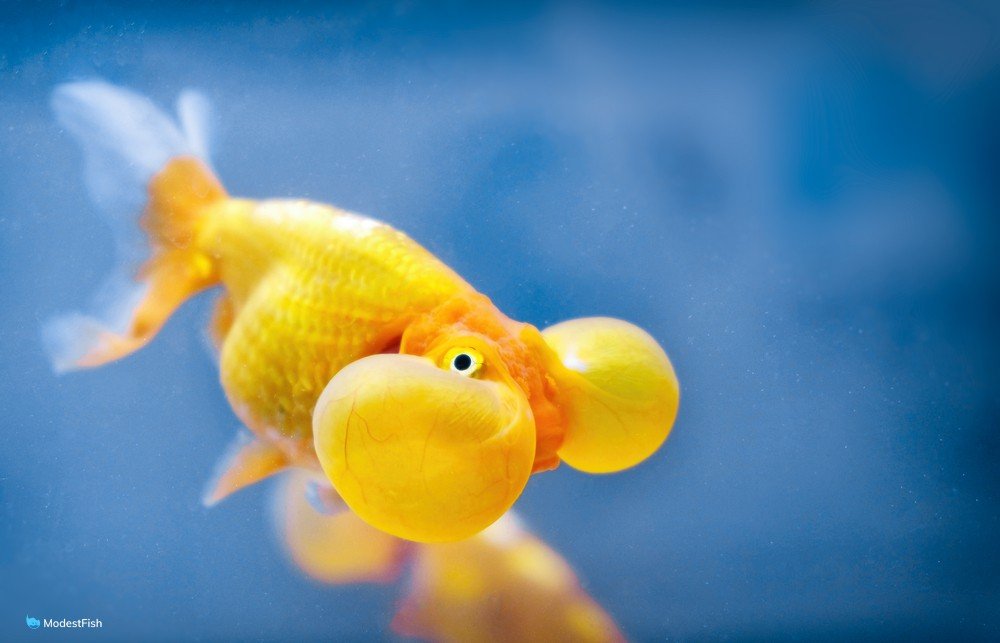
- Care Level: Moderate.
- Temperament: Peaceful and social.
- Size: 6 inches.
- Min Tank Size: 20 gallons.
- Diet: Flake food and pellets, with occasional live or frozen foods. Also, some greens.
The bubble eye goldfish is named for the fragile, fluid-filled sacs under its eyes. These sacs continue to grow with the fish and can reach an impressive size, but they can pop when damaged so they need an aquarium with no sharp edges or corners. The bubble may grow back and popping doesn’t cause damage to the eye itself, but there is the risk of infection.
The fish itself has an egg-shaped body and they have no dorsal fin. There are also several color varieties, including orange, yellow, and calico.
They should only be housed with other slow goldfish varieties as faster ones will outcompete them for food. In addition, their bubbles can sometimes obscure their vision, which makes finding food even more difficult.
5. Telescope
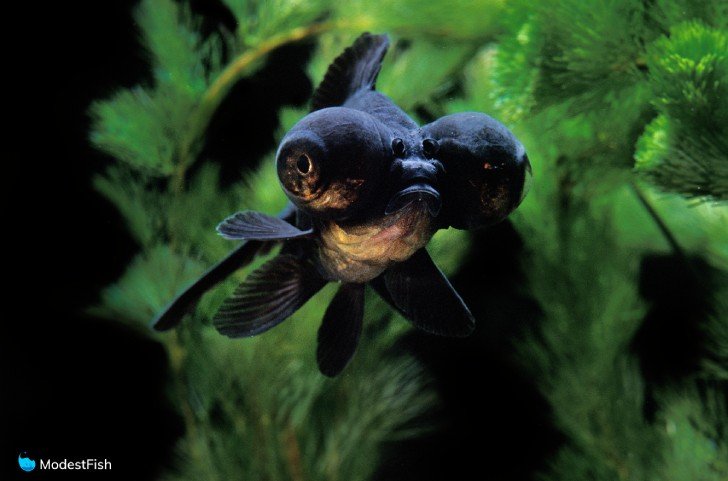
- Care Level: Easy.
- Temperament: Peaceful and social.
- Size: 4 to 10 inches.
- Min Tank Size: 30 gallons.
- Diet: Flakes and pellets with occasional greens. Some live or frozen food, though protein intake should be limited.
Telescope goldfish are characterised by their round protruding eyes that develop with age. This variety is sometimes known by its Japanese name, demekin. Like other goldfish, there are a number of different color varieties available.
There are also more specific variants of telescope goldfish, such as the popular black moor. Black moors have a velvety appearance, with few to no metallic scales. They rarely stay black forever, though, and often develop orange patches as they get older.
There is also the panda telescope, which is much sought after. It is a typical telescope goldfish, but with a black and white color pattern. Like black moors, they may lose this appearance as they age.
The eyes of a telescope goldfish are less fragile than those of the bubble eye, but it’s still important to avoid sharp edges as any damage can result in eye loss.
6. Celestial Eye
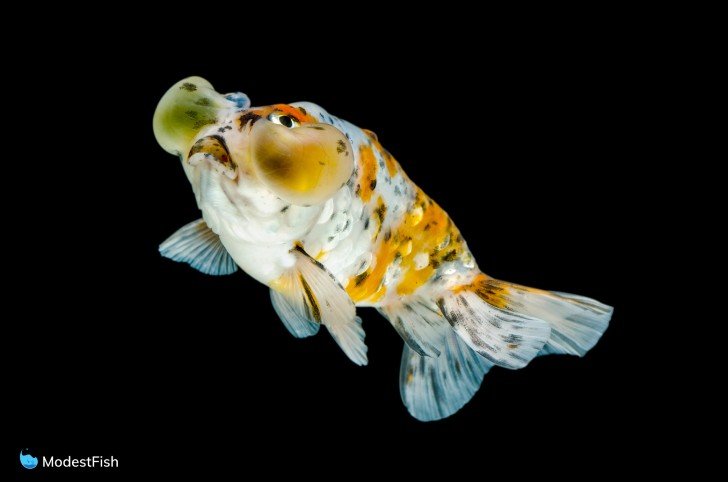
- Care Level: Moderate.
- Temperament: Peaceful and social.
- Size: 5 inches.
- Min Tank Size: 30 gallons.
- Diet: Flakes and pellets with occasional greens. Some live or frozen food, though protein intake should be limited.
The celestial eye goldfish was selectively bred from a mutation of the telescope goldfish, and was likely first bred in the 18th century. The main differences are that their eyes face upwards, instead of out to the sides, and they lack a dorsal fin.
Because of their upward-facing eyes, the fish doesn’t have great vision and so tank mates need to be chosen wisely. They won’t be able to compete with faster fish, or those with better vision, during feeding time.
7. Pompon
- Care Level: Moderate.
- Temperament: Peaceful and social.
- Size: 6 inches.
- Min Tank Size: 30 gallons.
- Diet: Flakes and pellets with plenty of greens. Some live or frozen food, though protein intake should be limited.
Pompon goldfish (often mistakenly called “pompom”) are characterised by the loose, fleshy growths on each side of their head, between the nostrils. These start growing when the fish are around 18 weeks old and take several months to develop. There are several color varieties available, including the chocolate pompon goldfish.
They are slow swimmers and can’t be housed with faster swimmers. The growths on their nose are also quite easily damaged so any sharp edges or pinch points must be removed from the aquarium to avoid injury and infection.
8. Pearlscale
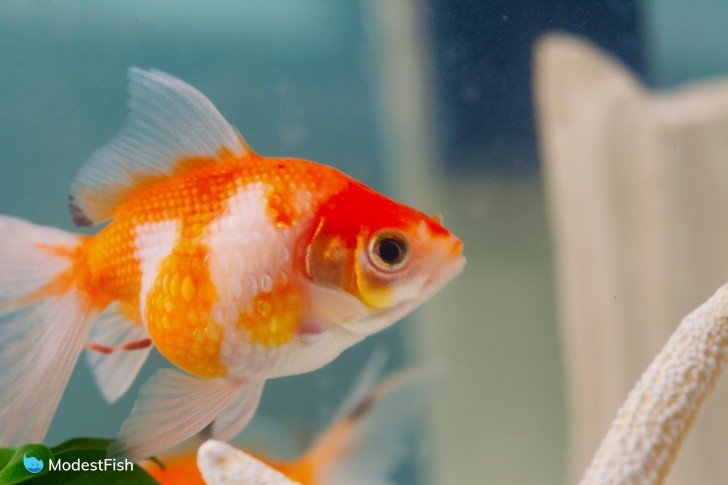
- Care Level: Difficult.
- Temperament: Peaceful and social.
- Size: 5 inches.
- Min Tank Size: 30 gallons.
- Diet: Flakes, pellets, and plenty of greens. Some live or frozen food, though protein intake should be limited.
The pearlscale is a very unusual looking goldfish. It has been selectively bred to have a very rounded body, almost resembling a golf ball. They also have thick, pearl-like scales, which is how they get their name.
These goldfish are not suitable for beginners as they are not particularly hardy. They are very sensitive and need really good water quality at all times. Due to their body shape, they are also prone to swim bladder problems and, in extreme cases, the swim bladder can stop working entirely.
9. Lionhead
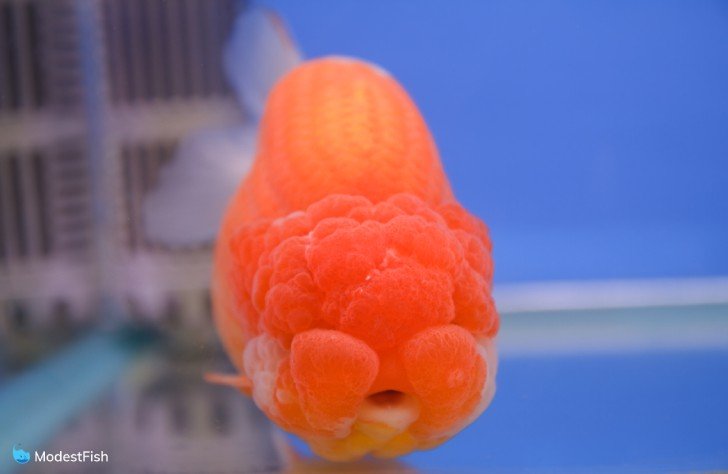
- Care Level: Moderate.
- Temperament: Peaceful and social.
- Size: 5 inches.
- Min Tank Size: 30 gallons.
- Diet: Flakes and pellets. They should also regularly be given some fresh foods and greens.
The lionhead goldfish was bred to resemble Chinese guardian lions. The have an extensive wen that sticks up from the head and even protrudes from their cheeks. They lack a dorsal fin and their body is slightly more elongated than that of other fancy goldfish varieties.
They are slow-moving goldfish, and their vision can become impaired if the wen covers their eyes. As a result, they can’t compete with faster goldfish varieties and should ideally only be kept with other lionheads, or possibly ranchus, which are a very similar goldfish variety.
Which Type of Goldfish Will You Pick?
Goldfish make great pets and have defended their title as the most popular aquarium fish for many years now.
With so many gorgeous varieties to choose from, it’s easy to see why. But it’s important to remember that any pet is a commitment. Each goldfish variety comes with unique needs and challenges, as well as unique rewards.
